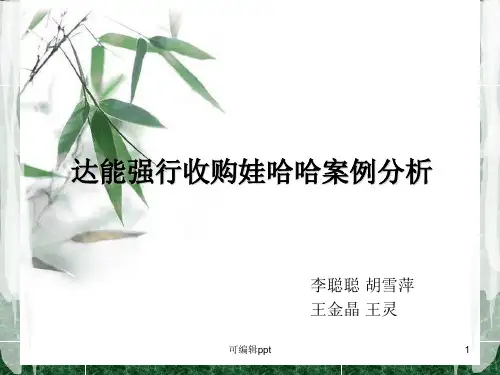娃哈哈与达能事件反思
- 格式:ppt
- 大小:531.50 KB
- 文档页数:8


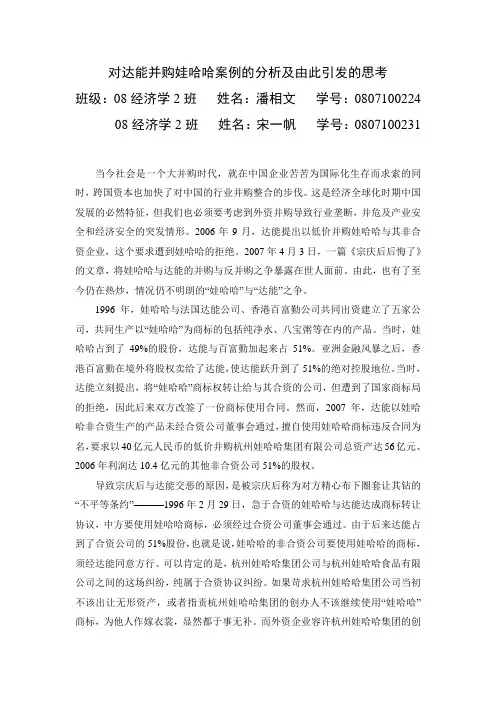
对达能并购娃哈哈案例的分析及由此引发的思考班级:08经济学2班姓名:潘相文学号:0807100224 08经济学2班姓名:宋一帆学号:0807100231当今社会是一个大并购时代,就在中国企业苦苦为国际化生存而求索的同时,跨国资本也加快了对中国的行业并购整合的步伐。
这是经济全球化时期中国发展的必然特征,但我们也必须要考虑到外资并购导致行业垄断,并危及产业安全和经济安全的突发情形。
2006年9月,达能提出以低价并购娃哈哈与其非合资企业,这个要求遭到娃哈哈的拒绝。
2007年4月3日,一篇《宗庆后后悔了》的文章,将娃哈哈与达能的并购与反并购之争暴露在世人面前。
由此,也有了至今仍在热炒,情况仍不明朗的“娃哈哈”与“达能”之争。
1996年,娃哈哈与法国达能公司、香港百富勤公司共同出资建立了五家公司,共同生产以“娃哈哈”为商标的包括纯净水、八宝粥等在内的产品。
当时,娃哈哈占到了49%的股份,达能与百富勤加起来占51%。
亚洲金融风暴之后,香港百富勤在境外将股权卖给了达能,使达能跃升到了51%的绝对控股地位。
当时,达能立刻提出,将“娃哈哈”商标权转让给与其合资的公司,但遭到了国家商标局的拒绝,因此后来双方改签了一份商标使用合同。
然而,2007年,达能以娃哈哈非合资生产的产品未经合资公司董事会通过,擅自使用娃哈哈商标违反合同为名,要求以40亿元人民币的低价并购杭州娃哈哈集团有限公司总资产达56亿元、2006年利润达10.4亿元的其他非合资公司51%的股权。
导致宗庆后与达能交恶的原因,是被宗庆后称为对方精心布下圈套让其钻的“不平等条约”———1996年2月29日,急于合资的娃哈哈与达能达成商标转让协议,中方要使用娃哈哈商标,必须经过合资公司董事会通过。
由于后来达能占到了合资公司的51%股份,也就是说,娃哈哈的非合资公司要使用娃哈哈的商标,须经达能同意方行。
可以肯定的是,杭州娃哈哈集团公司与杭州娃哈哈食品有限公司之间的这场纠纷,纯属于合资协议纠纷。
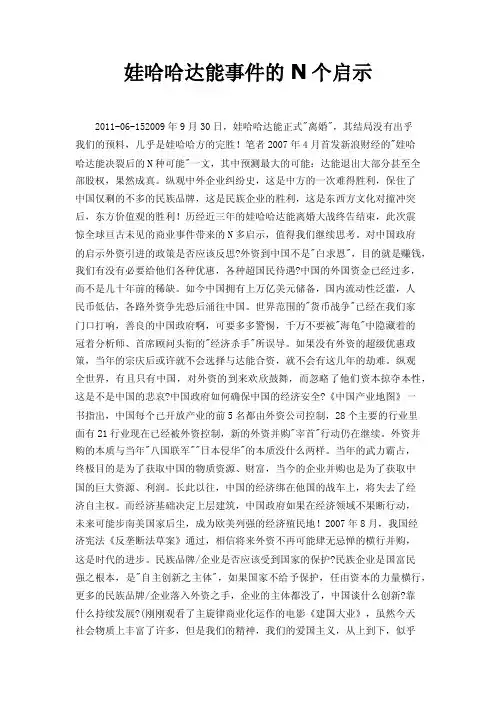
娃哈哈达能事件的N个启示2011-06-152009年9月30日,娃哈哈达能正式"离婚",其结局没有出乎我们的预料,几乎是娃哈哈方的完胜!笔者2007年4月首发新浪财经的"娃哈哈达能决裂后的N种可能"一文,其中预测最大的可能:达能退出大部分甚至全部股权,果然成真。
纵观中外企业纠纷史,这是中方的一次难得胜利,保住了中国仅剩的不多的民族品牌,这是民族企业的胜利,这是东西方文化对撞冲突后,东方价值观的胜利!历经近三年的娃哈哈达能离婚大战终告结束,此次震惊全球亘古未见的商业事件带来的N多启示,值得我们继续思考。
对中国政府的启示外资引进的政策是否应该反思?外资到中国不是"白求恩",目的就是赚钱,我们有没有必要给他们各种优惠,各种超国民待遇?中国的外国资金已经过多,而不是几十年前的稀缺。
如今中国拥有上万亿美元储备,国内流动性泛滥,人民币低估,各路外资争先恐后涌往中国。
世界范围的"货币战争"已经在我们家门口打响,善良的中国政府啊,可要多多警惕,千万不要被"海龟"中隐藏着的冠着分析师、首席顾问头衔的"经济杀手"所误导。
如果没有外资的超级优惠政策,当年的宗庆后或许就不会选择与达能合资,就不会有这几年的劫难。
纵观全世界,有且只有中国,对外资的到来欢欣鼓舞,而忽略了他们资本掠夺本性,这是不是中国的悲哀?中国政府如何确保中国的经济安全?《中国产业地图》一书指出,中国每个已开放产业的前5名都由外资公司控制,28个主要的行业里面有21行业现在已经被外资控制,新的外资并购"宰首"行动仍在继续。
外资并购的本质与当年"八国联军""日本侵华"的本质没什么两样。
当年的武力霸占,终极目的是为了获取中国的物质资源、财富,当今的企业并购也是为了获取中国的巨大资源、利润。
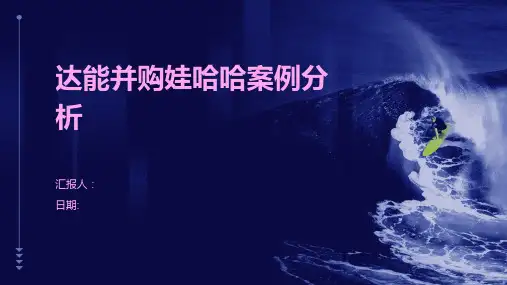
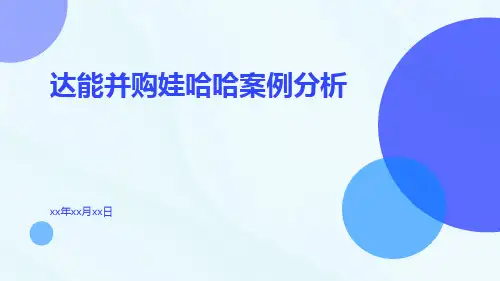
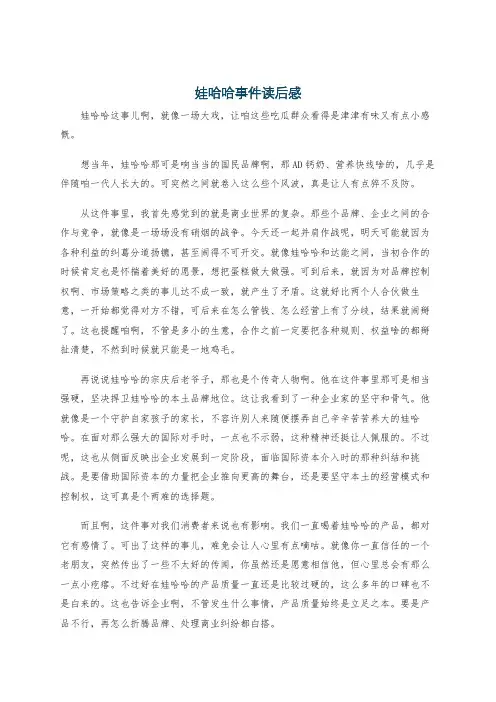
娃哈哈事件读后感娃哈哈这事儿啊,就像一场大戏,让咱这些吃瓜群众看得是津津有味又有点小感慨。
想当年,娃哈哈那可是响当当的国民品牌啊,那AD钙奶、营养快线啥的,几乎是伴随咱一代人长大的。
可突然之间就卷入这么些个风波,真是让人有点猝不及防。
从这件事里,我首先感觉到的就是商业世界的复杂。
那些个品牌、企业之间的合作与竞争,就像是一场场没有硝烟的战争。
今天还一起并肩作战呢,明天可能就因为各种利益的纠葛分道扬镳,甚至闹得不可开交。
就像娃哈哈和达能之间,当初合作的时候肯定也是怀揣着美好的愿景,想把蛋糕做大做强。
可到后来,就因为对品牌控制权啊、市场策略之类的事儿达不成一致,就产生了矛盾。
这就好比两个人合伙做生意,一开始都觉得对方不错,可后来在怎么管钱、怎么经营上有了分歧,结果就闹掰了。
这也提醒咱啊,不管是多小的生意,合作之前一定要把各种规则、权益啥的都掰扯清楚,不然到时候就只能是一地鸡毛。
再说说娃哈哈的宗庆后老爷子,那也是个传奇人物啊。
他在这件事里那可是相当强硬,坚决捍卫娃哈哈的本土品牌地位。
这让我看到了一种企业家的坚守和骨气。
他就像是一个守护自家孩子的家长,不容许别人来随便摆弄自己辛辛苦苦养大的娃哈哈。
在面对那么强大的国际对手时,一点也不示弱,这种精神还挺让人佩服的。
不过呢,这也从侧面反映出企业发展到一定阶段,面临国际资本介入时的那种纠结和挑战。
是要借助国际资本的力量把企业推向更高的舞台,还是要坚守本土的经营模式和控制权,这可真是个两难的选择题。
而且啊,这件事对我们消费者来说也有影响。
我们一直喝着娃哈哈的产品,都对它有感情了。
可出了这样的事儿,难免会让人心里有点嘀咕。
就像你一直信任的一个老朋友,突然传出了一些不太好的传闻,你虽然还是愿意相信他,但心里总会有那么一点小疙瘩。
不过好在娃哈哈的产品质量一直还是比较过硬的,这么多年的口碑也不是白来的。
这也告诉企业啊,不管发生什么事情,产品质量始终是立足之本。
要是产品不行,再怎么折腾品牌、处理商业纠纷都白搭。
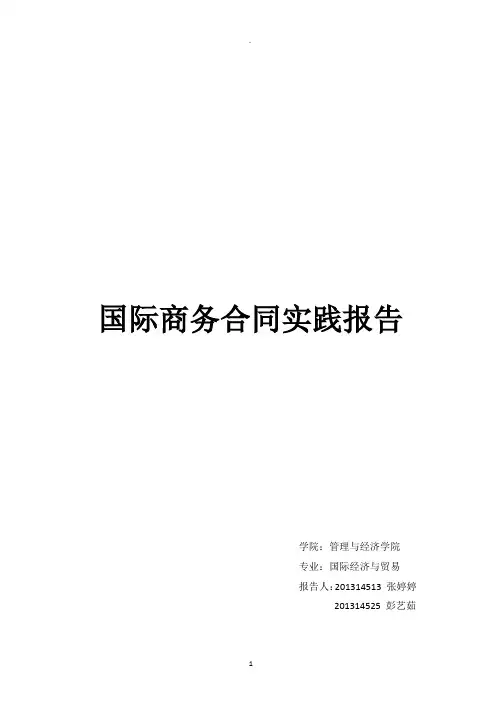
国际商务合同实践报告学院:管理与经济学院专业:国际经济与贸易报告人:201314513 张婷婷201314525 彭艺茹目录一.案例介绍1.1原文介绍1.2原文翻译1.3案例概述二.案例分析三.结局反思一.案例介绍1.1原文介绍:BackgroundIf you are in China,chances are you drink at least one bottle of Wahaha brand water,or perhaps the company’s iced tea,fruit drinks,or its Future Cola.If you go to the United States,you may even come cross Future Cola in New York or Los Angeles,because the company that first set up shop in an elementary school in Hangzhou,Zhejiang,is going global.The Hangzhou Wahaha Group Co.,Ltd.,China’s leading domestic beverage producer,didn’t achieve success overnight.The company’s predecessor,the Hangzhou Shangcheng District School-Run Enterprise Sales Department,funded its start-up operations in 1987 with a government loan.Zong Qinghou,the company’s founder,and two retired schoolteachers initially sold milk products and popsicles out of a school store,but to benefit the student’s health the group soon began producing and selling nutritional drinks.The company’s success selling nutrition products in school led to its first big expansion:with Hangzhou government support,the company acquired a company then changed its name to the Hangzhou Wahaha Group Co.(The word “Wahaha”is meant to mimic the sound of a baby laughing and is taken from a children’s folk song.)Wahaha’s second large-scale expansion occurred in 1994 when the company merged with three insolvent companies in Fulling,Sichuan,to set up its first factory in Chongqing.The Wahaha Joint Venture (JV)was formed in February,1996.At the start,there were three participants in the JV:Hangzhou Wahaha Food Group(Wahaha Group),led by its chairman Zong Qinghou;Danone Group,a French corporation(Danone);and Bai Fu Qin,a Hong Kong corporation(Baifu).In 1996,the two parties signed a trademark tranfer agreement,with anintention to transfer the”Wahaha”trademark to the joint ventures.The move,however,was not approved by the State Trademark Office.For this reason,the two parties signed in 1999 the trademark licensing contract.According to law,the same subject can not be synchronously transferred and licensed the use to others by the same lost.Therefore,the signing and fulfillment of the trademark licensing contract showed that the two parties had connived the invalidation of the transfer agreement.The”Wahaha”brand should belong to the Wahaha Group,while the joint ventures only have right of use.In October,2005,the two parties inked the No.1 amendment agreement to the trademark licensing contract,in which it confirmed Party A(Hangzhou Wahaha Group Co.,Ltd.)as owner of the trademark.In addition,the second provision of the amendment agreement clearly stated that the several Wahaha subsidiaries listed in the fifth annex of the licensing contract as well as other Wahaha subsidiaries(referred to as”licensed Wahaha enterprises”)established by Party A or its affiliates following the signing of the licensing contract also have right granted by one party to use the trademark.The “licensed Wahaha enterprises”involved in the amendment agreement refer to the non-joint ventures.According to related files,Wahaha owns the ownership of the “Wahaha”trademark,while its non-joint ventures have the right to use the trademark.The Danone-Wahaha Feud--Trademark LicenseFrom May,2007 when Danone initiated legal proceeding against Wahaha,the both sides have carried out several dozen lawsuits worldwide.As of May,2009,Danone not only lost a series of cases against Zong Qinghou and the non-joint ventures in China,but directors of Danone were deemed by many courts to have violated the non-compete obligation of directors,and litigations filed in the U.S.,Italy,France and British Virgin Islands(BVI)were alsodismissed.Now,Wahaha defeats Danone 37:0 in the lawsuits in and out of China.The ownership and use right of the Wahaha trademark is one of the focuses of the”Danone-Wahaha feud.”Danone often insisted that the Wahaha trademark belonged to the joint ventures,so the use of the trademark by non-joint ventures constituted infringement.But Wahaha Group disagreed with that,and emphasized that it was the true holder of the trademark,and the use of the trademark by non-joint ventures was legal.At the beginning of the Danone-Wahaha “marriage,” Wahaha signed a transfer agreement on the ownership of the Wahaha trademark with the joint ventures,and filed a trademark transfer application with the State Trademark Office,which,however,was not approved.”It actually declared the termination of the transfer contract,and the Wahaha trademark is still owned by the Wahaha Group,”said Ye Zhijian,a lawyer who knows the case.Afterward,the two parties signed a trademark licensing contract in 1999 to substitute the original transfer agreement.Both the licensing contract and the consequent No.1 amendment agreement clarify that the non-joint ventures of Wahaha have the right to use the Wahaha trademark.“It was known to and recognized by Danone that the non-joint ventures OEM for the joint ventures,so how could it be possible for the non-joint ventures to use a different trademark from the joint ventures?”Ye noted.To confirm the ownership of the Wahaha trademark,Wahaha referred to the Hangzhou Arbitration Commission for arbitration in accordance with the trademark transfer agreement.In December,2007,the commission made a decision that the trademark transfer agreement between Danone and Wahaha had terminated,and the Wahaha trademark belonged to the Wahaha ter,the Hangzhou Intermediate People’s Court affirmed the ruling.1.2 原文翻译:背景如果你在中国,那么你至少喝一瓶娃哈哈品牌水,或者公司的冰茶,果汁饮料,或非常可乐。

由娃哈哈与达能合资纷争案例引发的思考作者:刘静夏彩云来源:《对外经贸实务》 2011年第9期■刘静夏彩云陕西科技大学随着我国改革开放的不断深化,越来越多的外资企业进入我国与本土企业进行合资合作,这一合资过程却暴露出了许多问题。
本文通过分析娃哈哈与达能的纷争,提出在中外企业合资中,我国企业民族自有品牌保护意识等问题的思考,力图探索在中国市场环境下适合双方企业合资合作的新模式。
一、事件回顾2009年9月30日持续3年的“达娃”之争,最终以达能接受娃哈哈3亿欧元和解费同意出售在39家合资公司里的51%的股权落幕。
这一持续3年的“达娃”之争又是怎样一步步发展的呢?1. 背景:法国达能集团是总部设在巴黎的欧洲第三大食品集团,产品遍及100多个国家。
在九十年代初开始进军中国,曾拥有乐百氏92%股权、梅林正广和50%股权、光明20.1%股权、汇源22.18%股权。
杭州娃哈哈集团是创建于1987年的一家校办企业,二十世纪中期已经发展为中国最大的食品饮料生产企业,并且成为全球第五大饮料生产企业。
2. 缘起:1996年,娃哈哈由于在国内上市失败,急于寻觅资金,最终与达能及百富勤合资成立五家合资公司,娃哈哈集团以现有厂房、设备、土地出资占49%的股份,香港百富勤与达能以现金出资占51%,后因百富勤破产,达能成为合资公司的最大控股方。
合资公司成立之时双方在合作协议中约定,娃哈哈集团同意向合资公司转让价值为1亿元的商标。
其中5000万作投资,另外5000万则向娃哈哈购买商标。
但是,这个商标转让协议不符合中国的有关法律,未能通过政府审核,后来双方在《商标使用许可合同》中规定:“中方将来可以使用商标在其他产品的生产和销售上,而这些产品项目已提交给娃哈哈与其合营企业的董事会进行考虑。
”接下来的几年中,娃哈哈集团先后建立了十几家与达能集团没有合资关系的非合资企业,主要生产饮料和食品,并以“娃哈哈”为商标。
3. 经过:2006年,达能以商标使用合同中娃哈哈集团“不应许可除娃哈哈达能合资公司外的任何其他方使用商标”为由,要求收购由娃哈哈职工集资持股成立并且与达能没有合资关系的公司。
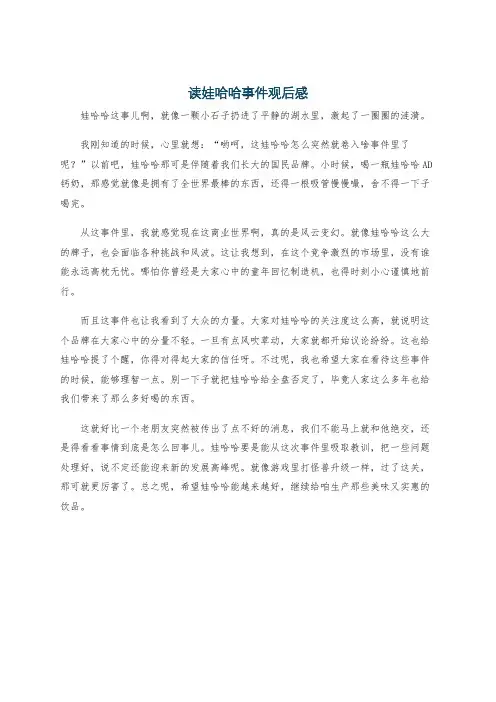
读娃哈哈事件观后感
娃哈哈这事儿啊,就像一颗小石子扔进了平静的湖水里,激起了一圈圈的涟漪。
我刚知道的时候,心里就想:“哟呵,这娃哈哈怎么突然就卷入啥事件里了呢?”以前吧,娃哈哈那可是伴随着我们长大的国民品牌。
小时候,喝一瓶娃哈哈AD 钙奶,那感觉就像是拥有了全世界最棒的东西,还得一根吸管慢慢嘬,舍不得一下子喝完。
从这事件里,我就感觉现在这商业世界啊,真的是风云变幻。
就像娃哈哈这么大的牌子,也会面临各种挑战和风波。
这让我想到,在这个竞争激烈的市场里,没有谁能永远高枕无忧。
哪怕你曾经是大家心中的童年回忆制造机,也得时刻小心谨慎地前行。
而且这事件也让我看到了大众的力量。
大家对娃哈哈的关注度这么高,就说明这个品牌在大家心中的分量不轻。
一旦有点风吹草动,大家就都开始议论纷纷。
这也给娃哈哈提了个醒,你得对得起大家的信任呀。
不过呢,我也希望大家在看待这些事件的时候,能够理智一点。
别一下子就把娃哈哈给全盘否定了,毕竟人家这么多年也给我们带来了那么多好喝的东西。
这就好比一个老朋友突然被传出了点不好的消息,我们不能马上就和他绝交,还是得看看事情到底是怎么回事儿。
娃哈哈要是能从这次事件里吸取教训,把一些问题处理好,说不定还能迎来新的发展高峰呢。
就像游戏里打怪兽升级一样,过了这关,那可就更厉害了。
总之呢,希望娃哈哈能越来越好,继续给咱生产那些美味又实惠的饮品。
